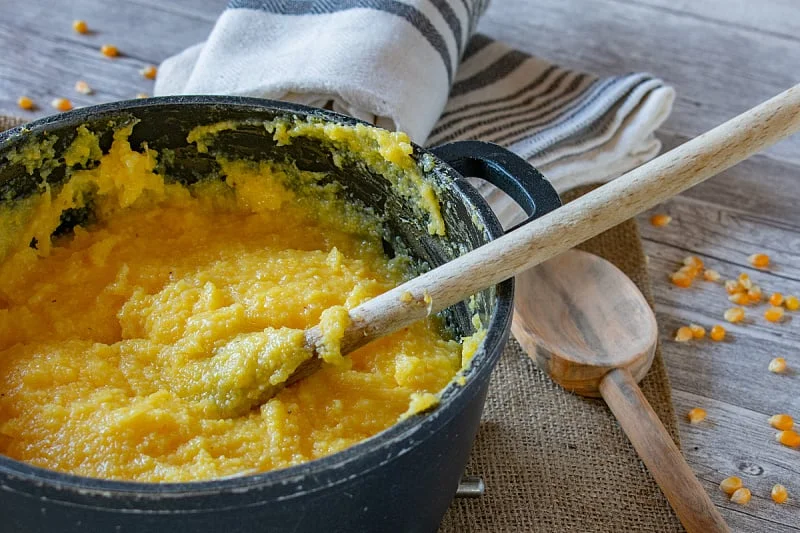Palentu (also spelled palenta) is a simple but deeply rooted dish made primarily of cornmeal cooked in liquid until it becomes thick — somewhere between a porridge and a solid base. In many cultures, it’s enjoyed soft and creamy, but once cooled it often becomes firm enough to slice, fry, grill, or bake.
The word palenta appears in various Slavic and Balkan languages, and its meaning is often very close to the Italian polenta. In Croatian, Serbian, Bosnian, Montenegrin, and related tongues, palenta / palentu refers to what in Italian would be polenta — but there are regional distinctions in texture, usage, and cooking.
So, in essence: palentu is polenta, or a very closely linked version of it, especially in Balkan culinary tradition. It’s a staple, comfort food — humble, filling, versatile. Different households may use milk, butter, cheese, sometimes sour dairy (yogurt, kajmak), or serve it with stews, vegetables, or meats.
Historical Origins of Palentu
Ancient roots before maize
Before corn (maize) became common in Europe, people used various grains and flours to make porridges: barley, millet, spelt, farro, chestnut meal, etc. Roman-era dishes like puls or pulmentum (Latin terms) were similar – basic mush or porridge cooked with water or other liquids. These ancient porridges form the precursors to what evolved into various cornmeal porridges.
Introduction of maize and transformation
Maize was brought to Europe from the Americas in the 16th century; it gradually replaced many of the older grains for porridges because of its yield, affordability, and ease of growth. Over time, recipes shifted, and cornmeal became the standard base for what we know as polenta / palenta / palentu. This change is mirrored across Italy, the Balkans, and other parts of Europe
Palenta / palentu in Balkan cuisines
In the Balkans, the word palenta / palentu appears in many languages to denote this cornmeal dish. It’s been adapted to local tastes — for example, by using local dairy (kajmak, sour milk, yogurt), herbs, or serving alongside typical Balkan stews and meats. In many rural areas, palentu is a daily staple. Recipes vary by country, village, and even family. For example, in Serbia, there’s a “Tačan recept za palentu” (“exact recipe”) in which cornmeal, water (or milk), salt, and butter are the core ingredients.
Ingredients & Varieties
Types of cornmeal / corn flour
The core ingredient of palentu is cornmeal. But there are important differences:
- Coarse vs fine grind: Fine cornmeal yields a smoother texture; coarse gives more graininess.
- Yellow vs white corn: Depending on local corn varieties; colour influences flavour and visual appeal.
- Instant / precooked vs traditional: Instant cornmeal cooks much faster but tends to lose some flavour and texture. Traditional raw cornmeal/bigger grind tends to need more time but yields richer, more complex taste.
Liquids: Water, milk, broths
Palentu is mostly cooked in water. Using stock or milk (or mixing water + milk) adds richness and flavour. Some recipes combine sour milk or yogurt for tang. The choice of liquid significantly influences the final taste and texture.
Additions: fats, dairy, flavouring
To enrich palentu, people often add:
- Butter or oil: For richness and smoother mouthfeel.
- Cheese: Fresh, aged, or local types (in the Balkans, cheeses like kajmak or other local cheeses are typical).
- Dairy extras: Cream, sour milk, yogurt.
- Herbs, garlic, salt: For savoury versions.
- Sweeteners or sweet flavours: Less common in Balkan tradition, but possible in adaptations.
Cooking Methods & Techniques
Ratio of liquid to cornmeal
This ratio is critical:
- More liquid → soft, creamy palentu (like a porridge).
- Less liquid → thicker, firmer palentu (once cooled, can be sliced or formed).
Typical recipes might use about 4 parts liquid to 1 part cornmeal (by volume) for something creamy. For firmer palentu, a lower ratio is used. In a Serbian “Tačan recept za palentu,” they use ~220 g cornmeal to 1.2 L water (or milk) for 6 portions.
Heat, stirring, avoiding lumps
- Pre-boil or near boiling of liquid first, then gradually add cornmeal while stirring constantly to avoid lumps.
- Use moderate heat; if heat is too high, bottom burns or it sprays, too low, takes too long.
- Stirring is important especially in early phases. As it thickens, less stirring needed but still something like stirring every so often to prevent sticking or lumps.
Soft vs Firm palentu: when to stop cooking
- For soft, creamy version: Stop when the cornmeal has absorbed liquid, is smooth, thick, but still spoonable.
- For firmer version: Cook a bit longer, or let it cool/mold so that starch retrogradation lets it firm up.
Cooling, molding, frying, grilling
After cooking, if desired:
- Spread into pans, let cool & set — then slice.
- Fry or grill slices for crispy exterior.
- Bake leftover palentu in casserole style.
This dual nature (warm creamy vs cooled and then used as solid base) is part of palentu’s versatility.
Traditional Recipes & Variants
Classic Balkan palentu recipe
One traditional recipe from Serbia (“Tačan recept za palentu”) uses:
- Cornmeal (~220g)
- Water (1.2 L), or milk
- Salt (~½ teaspoon)
- Butter (~40g) added at end
The process: bring water + salt to heat, before boiling add cornmeal in a steady stream while stirring; cook until thickened (about 7-8 minutes), then add butter. It can be eaten hot, or allowed to cool and moulded.
Palentu with cheese / kajmak / sour milk
A recipe from Coolinarika describes palentu served with melted butter, fresh cheese or kajmak, sometimes sour cream or yogurt, and garlic.
These versions add richness and local flavor.
Sweet vs savoury versions
Most traditional Balkan palentu is savoury — salt, butter, dairy, use with meats or vegetables. Sweet versions are less common locally but exist in other cultural adaptations (e.g. adding sugar, fruit, or sweet toppings).
Modern/fusion takes
Chefs and home cooks might add:
- Mixed herbs
- Mushrooms or other vegetables
- Use stock instead of water for deeper flavor
- Pair with meat braises, seafood, sauces
- Use palentu slices as alternative to polenta cakes, even as a gluten-free side dish
Nutritional Profile
Macronutrients
- Carbohydrates are the main component – the energy source. Cornmeal is rich in starch.
- Protein is modest; cornmeal is not high-protein compared to beans, meats, or dairy, though additions (cheese, milk) increase it.
- Fats depend on what additions are used (butter, cheese, dairy). Basic palentu with just cornmeal and water is low fat.
Vitamins, minerals, fiber
- Fiber: Whole grain cornmeal contains more fiber than refined cornmeal. Helps digestion, gives longer satiety.
- Vitamins: B vitamins (niacin, thiamine) are present in corn.
- Minerals: Magnesium, phosphorus, some iron. Amount depends on corn variety.
Comparison: whole grain vs refined cornmeal
Whole grain retains more of the bran, germ etc., giving more fiber, nutrients. Refined cornmeal is lighter in color, smoother texture, but less nutritional density.
Suitability for dietary restrictions
- Gluten‐free: Yes — corn is naturally gluten free. Good for those with celiac disease or gluten intolerance. Unless cross-contamination occurs.
- Vegetarian / vegan: Possible if using water and vegan fats, avoiding dairy in additions.
- Low fat / high fibre: Using minimal fats, whole grain cornmeal, lean additions helps.
Cultural Significance
Palentu in everyday meals vs special occasions
In many Balkan households, palentu is everyday food — breakfast, side dish, or main when other ingredients are scarce. It’s comforting, inexpensive. On special occasions or family gatherings, palentu might be served with richer accompaniments (cheese, meat, special sauces).
Comfort food, symbol of tradition
Palentu often evokes memories of childhood, rural life, simple kitchens, communal meals. It represents resourcefulness — “making a satisfying meal from minimal, humble ingredients.”
Literature, folklore, identity
Though not always prominent in literature, foods like palentu figure in oral traditions, stories of hospitality, folk sayings about food and sustenance. It’s part of national/regional identity in places.
Palentu in Modern Gastronomy
Restaurant / Fine Dining Versions
Modern chefs may:
- Use palentu as a base for plating high end proteins (game, seafood).
- Infuse with flavours – truffles, special cheeses, herbs.
- Use fancy presentation ( crisp slices, caramelised edges ).
Street Food / Snack Uses
Slices of cooled palentu are sometimes fried or grilled and served as snacks; sometimes topped with condiments, sauces, or eaten with garlic yogurt etc.
International variations & Influence
Similar dishes in Romania (mămăligă), Italy (polenta), elsewhere. The idea of cooked grain/flour mush is very common across cultures, adapted to local crop (corn, millet, wheat etc.).
Tips for Perfect Palentu
- Gradual addition of cornmeal: add slowly to boiling (or near‐boiling) water while stirring to avoid lumps.
- Use the right grind: fine grind for creamy texture, coarser for more “bite”.
- Watch the temperature: moderate heat, not too high, especially after adding cornmeal.
- Stir enough but not excessively: frequent stirring early on, later just occasional.
- Let it rest if needed: for firm versions, let it cool in a mold/pan.
- Add flavour at the right time: butter at end, cheese just before serving, herbs fresh etc.
- Reheating & leftovers: when reheating soft form, add extra liquid; firm forms can be sliced and crisped up in pan or grill.
Sustainability & Economy
- Minimal ingredients: cornmeal, water (or just milk), salt — cheap, readily available.
- Low waste: leftovers can be repurposed (fried slices, casseroles etc.).
- Corn as a high-yield crop: generally efficient, depending on how it’s grown, regionally appropriate.
It makes for an economical and sustainable food choice in many contexts.
Palentu vs Similar Foods
| Dish | Region / Culture | Base Ingredient | Key Differences vs Palentu |
|---|---|---|---|
| Polenta | Italy | Cornmeal | Very similar; difference mostly in terminology, texture variations. |
| Mămăligă | Romania | Cornmeal | Usually softer/more traditional accompaniments; sometimes more porridge-like. |
| Kačamak / Kačama | Balkans | Cornmeal / maize flour / sometimes potatoes | Similar preparation; may differ in consistency, accompaniments. |
| Grits | U.S. South | Cornmeal (hominy grits etc.) | Different corn type; flavour profile; often served differently. |
So many dishes globally are analogous. What sets palentu apart are local customs in cooking, accompaniments, and cultural framing.
Step-by-Step Guide: How to Make Palentu at Home
Ingredients (for ~4 servings)
- 200-250 g cornmeal (medium or coarse grind)
- 800 ml water (or a mix water + milk)
- Salt, about ½ teaspoon (adjust to taste)
- 30-40 g butter (or oil)
- Optional: cheese, sour milk / yogurt / kajmak, herbs, garlic
Preparation Steps
- Bring the water (or water + milk) + salt to heat; almost boiling but not violently boiling.
- Gradually pour in the cornmeal while stirring continuously so no lumps form.
- Reduce heat; let cook, stirring now and then, until mixture thickens and cornmeal absorbs most of the liquid (this may take 7-15 minutes depending on grind).
- Add butter (or oil) near end; incorporate fully. If using cheese, add when mixture is just cooked, letting it melt in.
Variations
- Savory: cheese, herbs, garlic, serve with meat/broth.
- Rich dairy: milk, cream, or sour milk.
- Firm version: once cooked, spread into baking dish or mold, let cool, then slice and grill/fry.
- Sweet (non‐traditional): add sugar, fruit compote, honey etc.
Serving Suggestions
- Hot bowl topped with butter and cheese
- Sliced cooled palentu, fried or grilled till crisp edges
- Side dish with stews, roasted meats, or vegetables
- Breakfast version with dairy or sweet toppings
Common Mistakes & How to Fix Them
| Problem | Cause | Fix / Prevention |
|---|---|---|
| Lumpy texture | Adding cornmeal too fast, insufficient stirring | Add slowly, stir continuously early on; use whisk if needed. |
| Too thick / pasty | Too little liquid, overcooking | Increase liquid; cook less, stop when thickness is just right. |
| Runny / too loose | Too much liquid, or stopping too early | Cook a bit longer, or reduce liquid amount. |
| Burnt bottom | Heat too high, not stirring enough | Lower heat, stir; use heavy-bottomed pan. |
| Bland taste | Not enough seasoning or flavouring additions | Use salted liquid; add butter, cheese, herbs, or serve with flavourful accompaniments. |
Palentu in Diet & Health Trends
- Because corn is naturally gluten-free, palentu is a great option for those avoiding gluten.
- Vegan/plant-based palentu: use water or plant milk, avoid dairy butter or cheese, use oil instead, maybe use nutritional yeast for flavour.
- High fiber / whole grain approaches: using whole cornmeal, less refined.
- For lower fat: reducing butter, using low fat dairy, minimal fat additions.
Palentu can be adapted to many dietary needs without losing its core character.
Conclusion & Why Palentu Endures
Palentu is more than just cornmeal and water. It’s history, culture, comfort, and adaptability all wrapped into one dish. From its ancient roots in porridges before maize, through its adoption of cornmeal after the Americas’ maize introduction, to its many regional variations in the Balkans and beyond, palentu has proven itself resilient and beloved.
Its simplicity is its strength — minimal ingredients, yet versatile in texture, flavour, and presentation. It can feed the masses, soothe hunger, be elevated in fine cuisine, or exist as humble nourishment in a rural kitchen. With modern dietary trends favouring gluten-free, plant-based, and whole grain foods, palentu is well positioned.
Whether you enjoy it creamy with cheese, fried slices with herbs, or as a side to stew, palentu holds a timeless place.
FAQs
Is palentu the same as polenta?
Essentially yes: palentu (or palenta) is the term used in many Balkan/Slavic contexts for what Italians call polenta. While there may be slight differences in texture, ingredients, or customs, the core dish is very similar — cornmeal cooked into a thick, often porridge-like base which can be served soft or firm.
What kind of cornmeal should I use? Coarse or fine?
It depends on texture you want. For a smooth, creamy palentu, a finer grind works better. For a more rustic texture with more bite, a coarser grind is desirable. Whole-grain cornmeal will add more flavour and fibre.
Can I make palentu gluten-free?
Yes. Corn is naturally gluten-free. Just ensure that the cornmeal is processed in a facility free of cross-contamination if you have severe intolerance or celiac disease. Also avoid any additions containing gluten.
How do I make palentu firm enough to slice and fry?
Use a slightly thicker mixture (less liquid), cook until the cornmeal is well hydrated and thick. Then pour into a mold or pan, let cool till set. Once set, you can slice it and fry, grill, or bake for crisp edges.
Can palentu be sweet?
Yes, although traditional Balkan versions are mostly savoury. You can adapt: use milk or milk + water, add sugar or honey, serve with fruit compote, nuts, cinnamon etc. The base process remains the same; flavour additions adjust to preference.





